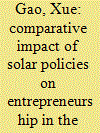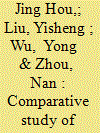|
|
|
Sort Order |
|
|
|
Items / Page
|
|
|
|
|
|
|
| Srl | Item |
| 1 |
ID:
179694


|
|
|
|
|
| Summary/Abstract |
The relationship between energy policies and entrepreneurship has long been a keen interest of researchers and policymakers. This study seeks to understand whether and how public policies affect—promote or hinder—the founding of new firms by examining the impact of solar regulatory and financial incentive policies on two types of new firm formation (i.e., start-ups and new subsidiaries) in the U.S. solar photovoltaic (PV) installation industry. This study finds that favorable regulatory policies are associated with an increased number of 2.8 start-ups and 1.6 new subsidiaries, and restrictive regulations (i.e., licensing policies) are associated with 2 fewer start-ups and 0.5 fewer new subsidiaries in a state. This study also finds that third-party ownership policy seems to have no impact on new firm formation. Furthermore, the relationship between financial incentives and new firm formation is not robust. This study suggests that policies that create a favorable business environment (or increase the barriers to business entry) may benefit (or hinder) different types of firms to varying degrees, as firms may have different levels of motivations, incentives, resources, and capacity to leverage these policies. Therefore, the distributional implications of policies should be taken into account in policy designs.
|
|
|
|
|
|
|
|
|
|
|
|
|
|
|
|
| 2 |
ID:
150362


|
|
|
|
|
| Summary/Abstract |
The energy efficiency of existing commercial buildings is more challenging to regulate and improve than the energy efficiency of new constructions. In 2011 and 2012, the Chinese Government selected four cities- Shanghai, Tianjin, Shenzhen, and Chongqing- to implement pilot commercial building energy efficiency retrofit program. Based on site surveys and expert interviews in these pilot cities, this research conducted a comparative analysis on incentive policies of local city level. The analysis results show that policy designs of existing commercial buildings should be further improved. The aspects that influence the implementation effect in the future, such as subsidy level, installments, and business model promotion, should be specified in the policy clauses. Referring to the technical solution and cost-benefit in Chongqing, we found that lighting system is the most common retrofit objects while envelope system is the least common one. And the subsidy incentive is greatest for educational buildings, followed by office buildings. In the end, we further discussed the problems and obstacles in commercial building retrofit market, and provided a series of recommendations.
|
|
|
|
|
|
|
|
|
|
|
|
|
|
|
|
| 3 |
ID:
179724


|
|
|
|
|
| Summary/Abstract |
Prefabrication construction method has been considered an effective way for enhancing the environmental performance and sustainable development of the construction industry. Many countries have imposed policies to stimulate the implementation of prefabrication. However, the efficiency of the incentive policies in China did not turn out as expected because of the existing benefit game between real estate enterprises and the government under the influence of consumers' purchasing intention. An evolutionary game model was established on the basis of 16 variables influencing the strategy selection of game players for determining the effective incentive policies. The interaction effect of the two players’ behaviours was discussed. Four probable scenarios of evolutionary stable strategy (ESS) exist in the game. However, the probabilities of “Incentive” from the government and “Implement” from real estate enterprises depend on the values of the 16 variables. The simulation of the evolutionary system was conducted to analyze the critical variables influencing the game. The increase of reputational incentives, financial incentives, the acceptance level of consumers and penalty and the reduction of additional costs can speed up the achievement of ESS between the government and real estate enterprises. Incentive policies should focus not only on real estate enterprises but also on consumers, manufacturers of prefabricated components and contractors.
|
|
|
|
|
|
|
|
|
|
|
|
|
|
|
|
| 4 |
ID:
176726


|
|
|
|
|
| Summary/Abstract |
China has a large and growing energy performance contracting (EPC) market. In 2017, the EPC investment was 111 billion CNY, making China the largest EPC market globally. EPC has played a significant role in driving energy efficiency improvement. This paper evaluates four key factors driving the EPC market and their interactions: incentive policies, China's Five-Year Plans, and business innovations in diversifying contract models and strengthening measurement and verification (M&V). We use multiple data sources: detailed information from 21 pilot projects, industry-wide surveys, and policy information. Our study indicates that supportive policies were important for the initial market development; after introducing government incentives in 2010, ESCO employees doubled within a year and the annual total energy savings from EPC projects increased from 11 million tce in 2010 to 34 million tce in 2015. As the market was established and continued to grow, the private sector undertook the initiative to address the issues that were left out of policies. By diversifying contract models and taking robust M&V practices, EPC stakeholders were able to overcome certain market barriers and enabled the sustainable growth of the market. Future EPC policies could incorporate business innovations to ensure long-term development of China's EPC market.
|
|
|
|
|
|
|
|
|
|
|
|
|
|
|
|
|
|
|
|
|